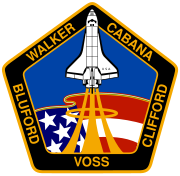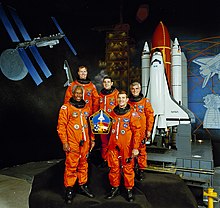STS-53

Discovery is launched on STS-53
|
|||||
| Mission type | Satellite deployment | ||||
|---|---|---|---|---|---|
| Operator | NASA | ||||
| COSPAR ID | 1992-086A | ||||
| SATCAT № | 22259 | ||||
| Mission duration | 7 days, 07 hours, 19 minutes, 17 seconds | ||||
| Distance travelled | 4,800,000 kilometres (3,000,000 mi) approx. | ||||
| Orbits completed | 116 | ||||
| Spacecraft properties | |||||
| Spacecraft | Space Shuttle Discovery | ||||
| Landing mass | 87,565 kilograms (193,048 lb) | ||||
| Payload mass | 11,860 kilograms (26,150 lb) | ||||
| Crew | |||||
| Crew size | 5 | ||||
| Members |
David M. Walker Robert D. Cabana Guion S. Bluford Michael R. Clifford James S. Voss |
||||
| Start of mission | |||||
| Launch date | 2 December 1992, 13:24:00 UTC | ||||
| Launch site | Kennedy LC-39A | ||||
| End of mission | |||||
| Landing date | 9 December 1992, 20:43:17 UTC | ||||
| Landing site | Edwards Runway 22 | ||||
| Orbital parameters | |||||
| Reference system | Geocentric | ||||
| Regime | Low Earth | ||||
| Perigee | 365 kilometres (227 mi) | ||||
| Apogee | 376 kilometres (234 mi) | ||||
| Inclination | 57.0 degrees | ||||
| Period | 92.0 min | ||||
|
|
|||||


Left to right - Front: Bluford, Voss; Back: Walker, Cabana, Clifford
STS-53 was a Space Shuttle Discovery mission in support of the United States Department of Defense. The mission was launched on 2 December 1992 from Kennedy Space Center, Florida.
Discovery carried a classified primary payload for the United States Department of Defense, two unclassified secondary payloads and nine unclassified middeck experiments.
Discovery's primary payload, USA-89 NSSDC ID 1992-086B is also known as "DoD-1", and was the shuttle's last major payload for the Department of Defense. The satellite was the third launch of a Satellite Data System-2 military communications satellite, after USA-40 on STS-28 and STS-38's deployment of USA-67.
Secondary payloads contained in or attached to Get Away Special (GAS) hardware in the cargo bay included the Orbital Debris Radar Calibration Spheres (ODERACS) and the combined Shuttle Glow Experiment/Cryogenic Heat Pipe Experiment (GCP).
...
Wikipedia
